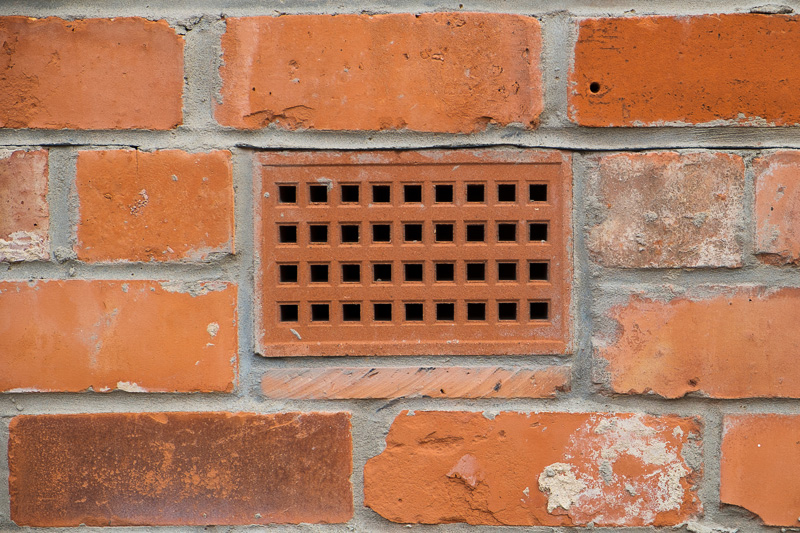Posted: 16th March 2023 | Author: Adam Brown | Category: Air Bricks
Back to news
Air bricks are useful things that help to prevent costly damp problems within homes. However, if you’re concerned about the implications of installing air bricks, you might be wondering if they’re really necessary.
Below, we’ll explain everything you need to be aware of.
Air bricks are typically used to increase the air flow and ventilation in underfloor spaces, particularly in houses with suspended floors. Creating an opening in the masonry allows outside air to get in and circulate. This helps to reduce the likelihood of damp problems developing in the joists which support the floor.
All homes are at risk of developing damp problems this way, but especially those that use central heating. This is because in the middle of winter, it is naturally very cold outside. Central heating helps to warm the fabric of the building, including the underfloor joists. But when the heating is turned off, these joists cool off and the moisture in the air condenses onto them. Moist timber, whether it’s in the floorboards or your joists, can rot and lose its structural integrity if this is allowed to continue. By creating extra underfloor ventilation, you allow that moisture to be taken out of the house before it can condense on the joists.
But the benefits of installing air bricks aren’t limited to avoiding damp problems - they’re also useful if you have a gas or solid fuel stove. These require extra ventilation because fires feed on the oxygen in the air. If there isn’t enough ventilation, these heating appliances can create carbon monoxide, which is toxic to breathe. Increasing the ventilation not only helps to prevent this, but it also helps to remove any carbon monoxide that is produced.
Like suspended floor voids, cavity walls are susceptible to unseen damp problems. They often require extra ventilation in order to avoid the effects of condensation on timber structures within your home.
If you live in a property that already has air bricks, you may at one time or another have considered blocking them over, putting furniture in front of them, or otherwise covering the vents. This may be in an attempt to block draughts or to prevent pests using the ventilation holes to get into your home. However, covering your air bricks is generally not advised because it defeats their purpose - and you might be setting yourself up for more problems further down the line.
All of the reasons we’ve outlined above that make it a good idea to have an air brick or two installed can become issues again if you then cover over the air bricks. Therefore, blocking ventilation can lead to damp problems in underfloor spaces or cavity walls. Covering air bricks may also affect the efficacy of gas or solid fuel heating systems like wood burners and gas stoves - and this could have pretty serious consequences for your health.
So does that mean you can never cover over an air brick? Well, though it’s rare, there may be circumstances where an air brick was installed but is no longer needed. For instance, if the previous property owner had a gas stove, but you’ve moved onto a new form of heating, you might not need the air brick for extra ventilation any more. If you suspect this is the case, the best thing to do is to consult an expert who can help you to understand the best course of action. In most cases, however, people find air bricks so unobtrusive that they’re fine to be left uncovered regardless of whether or not they’re strictly necessary.
You might have heard that mice can get through a hole the size of a pencil. It’s definitely true that they can seem to pop up out of nowhere, which can be distressing if you’re not fond of the little creatures. If you have an air brick, it does add an extra point of entry for mice and other small pests to enter your home - but don’t let that put you off. Wire mesh is a great solution that effectively bars the entrance for mice and other creatures without blocking air circulation. This means you still benefit from the extra ventilation without having to worry about little intruders.
It’s important to choose wire mesh and not plastic, as mice have a tendency to chew through plastic mesh and find a way in. Alternatively, you could always try purpose built air brick covers instead. These are specially designed to keep pests out while letting the fresh air in.
Back to news
The Author: Adam Brown
With a background as a Mechanical Engineer, I started Nationwide Supplies alongside my brother with a vision to modernise what seemed a stuck-in-its-ways industry in the builders merchant sector. Since 2011 it has been my goal to source quality products at the correct prices to be able to offer a saving to customers along with high quality customer service which offers quick delivery and superior technical knowledge in the industry.